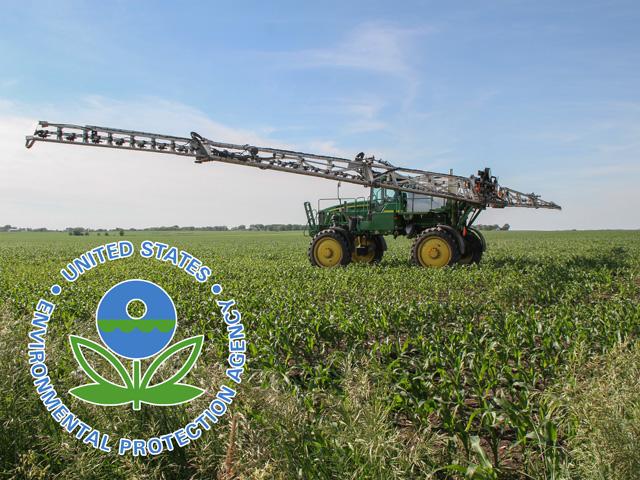New Dicamba Labels
A Breakdown of Changes to the 2020 Dicamba Labels
ROCKVILLE, Md. (DTN) -- EPA released three new dicamba over-the-top herbicide labels on Tuesday: XtendiMax (Bayer), Engenia (BASF) and Tavium (Syngenta).
(FeXapan -- Corteva Agriscience's marketed version of XtendiMax -- is not yet registered for use, but Corteva confirmed to DTN that the company will be seeking a federal registration of the product now that XtendiMax is registered).
The three new labels come with many pages of details and use restrictions, some old, some new. DTN analyzed each one to see what changes were made from the 2018 registration, as well as what might look familiar to applicators. Here's the breakdown.
WHAT DID CHANGE
Here is a chart detailing how the new dicamba labels differ from the 2018 labels of Xtendimax and Engenia and the 2019 label of Tavium:
| LABEL SECTION | OLD 2018 LABELS(*2019 for Tavium) | NEW 2020 LABELS |
| Size of Label | 40 pages (XtendiMax); 27 pages (Engenia); 30 pages (Tavium) | 17 pages (XtendiMax); 21 pages (Engenia); 34 pages (Tavium) |
| Length of Registration | 2-year registration | 5-year registration (ends 2025) |
| Labeled Crops | Engenia and XtendiMax: Xtend (dicamba-tolerant) crops listed alongside a large group of non-dicamba-tolerant crops Tavium: dicamba-tolerant (Xtend) crops and non-dicamba-tolerant soybeans listed. | All three: Only labeled for use with two dicamba-tolerant crops (Xtend RR2/XtendFlex soybeans and XtendFlex cotton) for all three herbicides. |
| Max Rate Permitted | XtendiMax: 44 oz/acre (1 lb. dicamba ae/acre) -- preemerge only; Engenia: 25.6 oz/acre (1 lb. dicamba ae/acre) -- preemerge only; Tavium: 3.53 pint/acre (0.5 lb. dicamba ae/acre and 1 lb. s-metolachlor/acre) | XtendiMax: 22 oz/acre (0.5 lb. dicamba ae/acre); Engenia: 12.8 oz/acre (0.5 lb. dicamba ae/acre); Tavium: 3.53 pint/acre (0.5 lb. dicamba ae/acre and 1 lb. metolachlor/acre) |
| Spray Timing Restriction | XtendiMax and Engenia: No applications after R1 or 45 days post-soybean planting; no spraying after mid-bloom or 60 days post-cotton planting; Tavium: No spraying after V4 or 45 days post-soybean planting; no applications after 6-leaf cotton or 60 days post-cotton planting. | All three: No spraying after June 30 in soybeans and after July 30 in cotton, plus: XtendiMax: No applications after R1 in soybeans; Engenia: No mention of growth stages; Tavium: No application after V4 in soybeans or after 6-leaf cotton. |
| Buffer for non-sensitive areas | 110-foot downwind buffer | 240-foot downwind buffer |
| Buffer for endangered species | 110-foot downwind buffer to limit spray drift + 57-foot omnidirectional buffer. | 310-foot downwind buffer to limit spray drift + 57-foot omnidirectional buffer. |
| Buffer Reduction Option | Did not exist. | Buffers for non-sensitive areas may be reduced to 110 feet, and buffers for endangered species may be reduced to 240 feet when using a qualified hooded sprayer in soybeans only. |
| Volatility Avoidance | Language suggesting applicators try to keep the pH of their tank mix above 5 to minimize volatility risks. | XtendiMax and Tavium require use of a qualified pH buffering adjuvant or VRA (volatility-reducing agent) AND a drift-reduction agent (DRA) in every application, to be listed on registrant websites. Engenia only requires the use of a pH buffering adjuvant. |
| Training Requirements | Dicamba or auxin-specific training required annually for all applicators by either the state or the registrants. | XtendiMax and Tavium: Dicamba or auxin-specific training required initially for all applicators by either the state or registrants, then every other year going forward; Engenia: Training still required annually; all three: The addition of some new required education on 2020 changes. |
| Recordkeeping requirements | Applicators must document a list of 14 to 20 required items (variation due to different item breakdowns between products) within 72 hours of application and keep records for two years. | Applicators must document all the same items within the same time period for two years, with the addition of the new 2020 requirements such as use of a buffering pH agent/VRA and hooded sprayer use. |
EPA also announced another change during its dicamba registration decision. The agency will no longer permit states to use Section 24(c) special local needs labels (SLNs) to add further restrictions to the federal dicamba labels, as many states have done in the past, mostly with temperature and cutoff dates.
From now on, the EPA will only allow states to create additional uses via 24(c) labels, per the language of the law. If states want to further restrict the federal label, they will have to use Section 24(a) of the Federal Insecticide, Fungicide and Rodenticide Act (FIFRA), which requires states go through their lawmaking or rule-making process. See more here: https://www.dtnpf.com/….
WHAT DID NOT CHANGE
Many of the 2020 label restrictions remain the same compared to the 2018 and 2019 labels. Unchanged requirements include:
P[L1] D[0x0] M[300x250] OOP[F] ADUNIT[] T[]
-- All three herbicides remain restricted use pesticides (RUP) that can only be handled by certified applicators.
-- Applications are still limited to 3 to 10 mph wind speeds, at sprayer speeds at or below 15 mph, with boom height no more than 24 inches above the crop canopy.
-- Applications are still prohibited within 48 hours of a rain forecast that could be expected to exceed soil capacity of a field.
-- Applications are still prohibited during temperature inversions and are limited to one hour after sunrise and two hours before sunset.
-- Applications are still banned if the wind is blowing to a sensitive crop or area.
-- Applicators are still required to check for the presence of endangered species in their county via the EPA's Bulletins Live 2 website.
-- Applicators are still required to check a sensitive crop registry for each field before applications.
-- The use of AMS (ammonium sulfate) and non-approved nozzles are still banned from use with these herbicides.
-- Triple-rinse cleanout procedures are still required with all three herbicides.
You can find the new labels in EPA's docket here: https://beta.regulations.gov/….
You can also find out more about each herbicide's new use restrictions and tank mix ingredients from their registrants' websites:
-- XtendiMax: https://www.roundupreadyxtend.com/….
-- Engenia: https://agriculture.basf.us/… and here: https://agriculture.basf.us/….
-- Tavium: https://www.syngenta-us.com/… and here: https://www.syngenta-us.com/….
Emily Unglesbee can be reached at Emily.unglesbee@dtn.com
Follow her on Twitter @Emily_Unglesbee
(c) Copyright 2020 DTN, LLC. All rights reserved.






